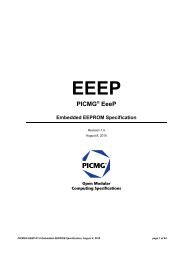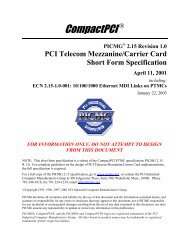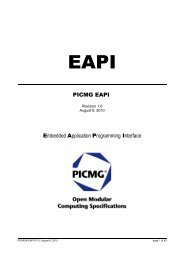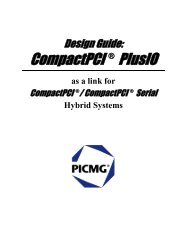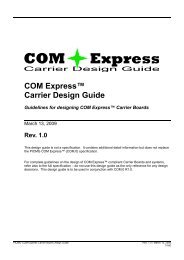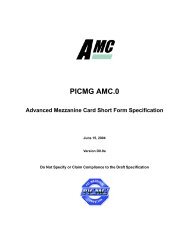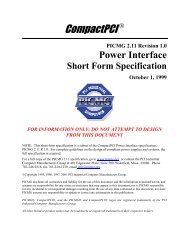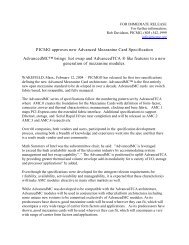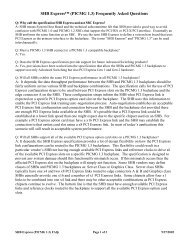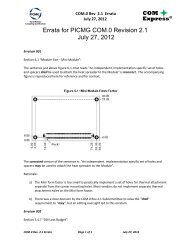PICMG 2.20, CompactPCI Serial Mesh Backplane
PICMG 2.20, CompactPCI Serial Mesh Backplane
PICMG 2.20, CompactPCI Serial Mesh Backplane
Create successful ePaper yourself
Turn your PDF publications into a flip-book with our unique Google optimized e-Paper software.
FOR INFORMATION ONLY;<br />
DO NOT ATTEMPT TO DESIGN FROM THIS DOCUMENT<br />
OVERVIEW<br />
The complete <strong>2.20</strong> specification defines a high-speed serial fabric for <strong>CompactPCI</strong> platforms.<br />
This fabric enables high performance transport of data for a wide variety of protocols. The<br />
fabric can serve applications for ATM, Frame Relay, and many proprietary packet protocols like<br />
those used in wireless telecom applications.<br />
The fabric consists of a rich set of differential serial signals capable of 1.25Gb/s, or 2.5Gb/s.<br />
The channels are arrayed in a “mesh” configuration that gives each slot a full set of<br />
interconnects to every other slot. This mesh arrangement supports a distributed switch fabric<br />
architecture. It has advantages in scalability and traffic management. The mesh may also be<br />
used as a subset of smaller fabrics in “star” configurations.<br />
The high-speed serial fabric is facilitated by a new connector family. The Zd connector family is<br />
supported by multiple vendors. This connector is specifically designed for high-speed<br />
differential signals up to 5Gb/s. The HM2 family currently used by <strong>CompactPCI</strong> will not support<br />
these kinds of signals.<br />
The fabric is located entirely within the space occupied by J4. It follows the precedent set by<br />
<strong>PICMG</strong> 2.5 (H.110) to use J4 as a common transport layer. This fabric is specifically oriented to<br />
packet-based applications. By utilizing J4, general-purpose boards (with no J4) will interoperate<br />
in standard <strong>CompactPCI</strong> systems, those with H.110 backplanes, and those with this high-speed<br />
serial fabric. This specification also co-exists in systems supporting <strong>PICMG</strong> 2.16.<br />
Switch Fabric Architecture<br />
Switching systems can be characterized in layers. Protocol specific switching systems interface<br />
to specific layer 2 packet formats like Ethernet or ATM. Many low to medium performance<br />
fabrics can now be implemented in a single device making all the specifics of the switching<br />
architecture internal.<br />
OC3<br />
LIU<br />
UTOPIA<br />
UTOPIA<br />
LIU<br />
OC3<br />
OC3<br />
LIU<br />
UTOPIA<br />
ATM<br />
SWITCH<br />
UTOPIA<br />
LIU<br />
OC3<br />
OC3<br />
LIU<br />
UTOPIA<br />
UTOPIA<br />
LIU<br />
OC3<br />
Figure 1: ATM Switch Example<br />
Higher end switches utilize more layers in their architecture. This is to facilitate higher data<br />
rates and more complex traffic classification and management. Higher end fabrics define<br />
devices like traffic managers and switch fabrics.<br />
<strong>CompactPCI</strong> <strong>Serial</strong> <strong>Mesh</strong> <strong>Backplane</strong> Short Form Specification




